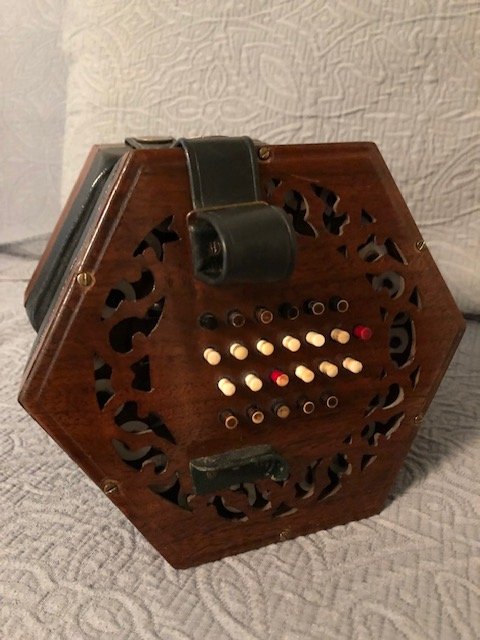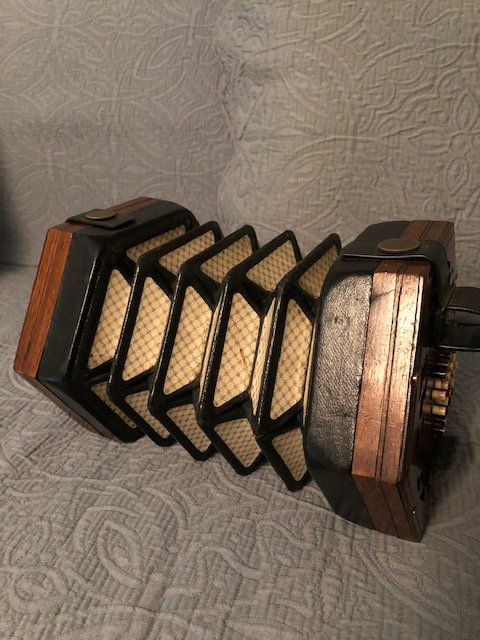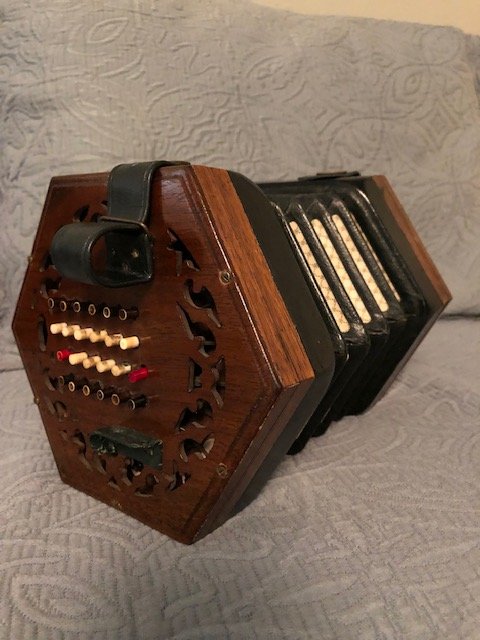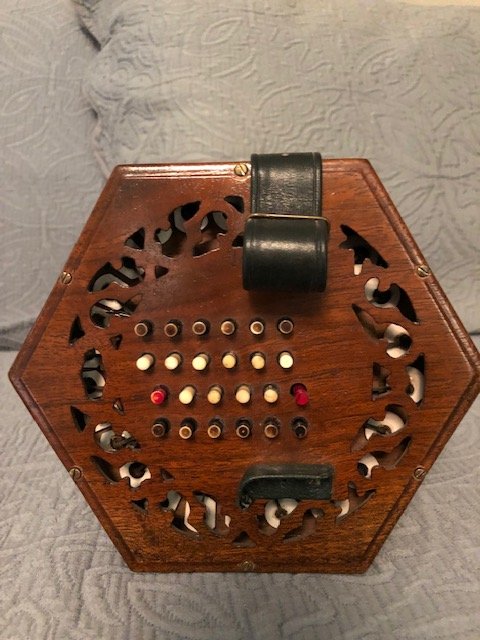
McDouglas
Members-
Posts
75 -
Joined
-
Last visited
Profile Information
-
Gender
Male
-
Interests
English concertina
-
Location
Dallas, Texas
Recent Profile Visitors
2,123 profile views
McDouglas's Achievements

Advanced Member (3/6)
-
Here's a video clip from worship at Wilshire Baptist Church in Dallas, Texas, 18 August 2019. The combination of EC with harp is lovely. These arrangements were originally for violin and harp - but I was able to play on it on my EC with no problem. I'm still not always happy with my bellows work (the key to the kingdom, eh?) but I'm getting there. And listening to this, I could afford to be more expressive with the phrasing (again, bellows work) - but we were pleased to share this with those gathered for worship. Thanks to Paul Hardy and Greg Jowaisas for their encouragement along the way!
-
-
The Frances Wilkins is indeed a wonderful article. Here's the link: http://www.concertina.org/wordpress/wp-content/uploads/2014/10/PICA09-2012.pdf
-
Que charmant!
- 19 replies
-
- notebook for anna magdalena
- bach
-
(and 2 more)
Tagged with:
-
I was not quite sure what to call this topic but I'd like to have some conversation about developing arrangements on the English concertina. For now some initial thoughts. I'll try to post an audio clip later today that will illustrate some of what I'm aiming for. 1. There may be nothing more beautiful than an unadorned melody expressively played. I've recently bought a vintage EC from Greg Jowaisas and I just love the sound of an old tune on this EC. 2. An arrangement in music may be similar to flower arranging in that you've got some flowers that are prominent for size and color but you also use other complementary elements (I'm not an expert but I've observed the use of other flower materials that add greens and grey hues for contrast). It seems to me intros and interludes and bridges help frame the melody - and work best if they are integrated with the melody, in other words, they are linked in some way to a melodic motif, something that's organic to the melody itself. 3. Should the melody itself be altered or can it morph into something else? Perhaps. If one may allow the melody to develop naturally and to be transformed through time, then fine. But there is a long tradition of "recapitulation" or a return to the primary theme in Western classical music. Why? I don't know exactly but there is a certain sort of delight for the listener who realizes, Oh nice, I recognize that part from earlier. 4. Some simple forms from classically-informed music: a. Sonata form: theme - development - recapitulation - coda b. Ternary: ABA c. Palindrome or Arch: ABCDCDBA d. Rondo: ABACADA 5. I understand this may step outside the bounds of traditional folk music which has its own conventions, but I'm just thinking about how one might consider arranging these wonderful melodies. I'm not exactly advocating for classical arrangements but rather arrangements that honor the folk tradition while being enriched by more development of tune and structure.
-
After playing English Concertina for about a year I decided I wanted to find a vintage instrument, that next level up from the entry level Jackie made by Concertina Connection (actually I've enjoyed playing it very much). It was on concertina.net that I ran across Greg Jowaisas' name and began corresponding with him. I live in Dallas, Texas, he lives in Kentucky. I inquired about what he might have to sell and he sent me a list of instruments (English, Anglo and Duet) with details and prices. I selected a few instruments in my price range and he subsequently sent me pictures and sound files. Greg answered all my questions and never gave me the "hard sell." Of course, at the end of the day there is no substitute for playing an instrument. Turns out I had to make a business trip to Louisville in January, so I arranged to stay an extra day and made a side trip to Greg's place to play and (hopefully) purchase a vintage instrument. Greg was generous with his time and helpful in making a selection that was right for me. Next to my days in Cambridgeshire last fall thanks to the hospitality of Paul Hardy, I have not had a more enjoyable day playing and learning and discussing concertinas. If you are in the market for a new instrument - or you need an instrument restored - I recommend Greg Jowaisas whole heartedly!
-
Looks like a wonderful instrument. I would be tempted if I have not just bought a new vintage EC from Greg Jowaisas.
-
What our concertinas look like?
McDouglas replied to new english's topic in General Concertina Discussion
Thanks to Greg Jowaisas, I've just purchased my first vintage English concertina. Wheatstone 48 buttons, brass reeds, rivet action, a warm and intimate sound that's going to be great for playing at home. -
Over several months I have read a number of threads advocating for Anglo or Duet or English concertinas with great interest. I had wondered after playing the EC for a year whether I ought to have chosen a different system. It has occurred to me recently that the chromatic nature of the English makes it ideal to play a wide range of keys and a broad range of music. Yes, I can play folk tunes in G and D easily. But when at Christmas the mandolin player of a group I played with wanted to play "Red Haired Boy" in A , well, no problem - I just made the adjustment. When I want to play in the mode of E minor and I want that raised 7th (D#), no problem - it's just a note away. When I decided to learn Mel Torme's "The Christmas Song" for fun this past month, no problem - the EC plays both diatonic lines in C and can move into the wonderful secondary harmonies that require Bb, Eb and Ab with no trouble. And now I'm learning a tango I found somewhere online: see attached file. Now I understand that there are tradeoffs. I can't "accompany myself" with as much facility as other systems seem to. But I am beginning to appreciate the EC is a remarkably flexible and adaptable instrument. Perhaps the lesson here is the journey of hard work to just begin to master an instrument is worth the time and patience required. I'm not there but I"m on the way. Your thoughts? Tango Argentin pdf.pdf
-
Lovely!
-
Which concertina would a pianist find easiest to play?
McDouglas replied to Rich C R's topic in General Concertina Discussion
Rich CR I've been playing piano since I was eight so it is the instrument I'm most comfortable with although I also play or have played saxophone, guitar and bass. I asked this same question almost exactly a year ago before purchasing an English Concertina. I suppose I hoped by picking a system that was somehow analogous to the piano (in some way) it would help me advance more rapidly. (One might make the case a Duet is a better analog: LH vs. RH). But here's the thing I've realized. I learned to play piano and guitar and saxophone at different times in life. Each informed the other and perhaps accelerated learning - but each required its own unique development of skill and muscle memory. I'm not sure I was asking the right question when I posed this a year ago. And maybe there is no correct answer. Bottom line: I've had a great time learning to play the EC and met some great folks this past fall in the UK because I dared to try to learn something new. -
Gary, Thanks. It's great to see a list like this. Thanks so much! McDouglas
-
Gcoover, will you say more about these "original sources"?










